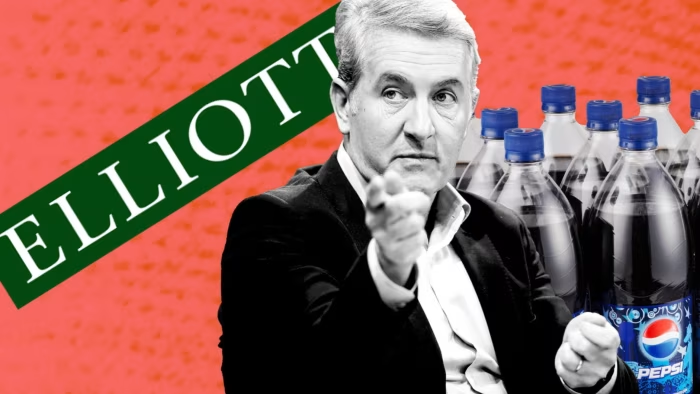- 1100 more electric buses to reach Punjab by December: CM RADIO PAKISTAN
- DCs get survey responsibility The Express Tribune
- Punjab to supply door-to-door bottled water in remote areas Aaj English TV
- Rawalpindi’s Electric Bus Service Launch Date…
Blog
-
1100 more electric buses to reach Punjab by December: CM – RADIO PAKISTAN
-

India’s POCL boosts green recycling with ACE Green investment
Key takeaways:
- POCL invested just over $500,000 in ACE Green to support green recycling – expanding capabilities and advancing green electrification in battery markets
- ACE Green is prioritizing LFP battery recycling over NCM,…
Continue Reading
-

PepsiCo chief under pressure as activist Elliott pushes for change
Ramon Laguarta was not widely known when he became PepsiCo’s chief executive in 2018, a veteran operator who had spent most of his career in Europe. His low profile stood in contrast to his former boss Indra Nooyi, one of few immigrant women atop corporate America and a regular at Davos with a keen eye for public relations.
Laguarta is now in the spotlight, willingly or not. Like Nooyi before him, he is staring down an activist investor agitating for a shake-up of the drinks and snacks powerhouse that owns brands such as Gatorade, Doritos and its namesake Pepsi cola.
The 29-year PepsiCo veteran on Thursday will face investors for the first time since hedge fund Elliott Management went public with a $4bn stake in the company last month, one of its biggest investments.
Thursday’s third-quarter results will be scrutinised for signs of how Laguarta will respond to Elliott’s demands. The earnings presentation is expected to be Laguarta’s last before the deadline for Elliott to wage a proxy contest at the end of November. How he rises to the challenge may determine whether the hedge fund takes that path.
The activist’s 75-page slide presentation asserts that weakening sales and profit margins in PepsiCo’s North American businesses and an unwieldy product portfolio have put it at a disadvantage to rival Coca-Cola and other competitors, wiping away more than $40bn in market capitalisation over the past three years.
Unsold bottles of Pepsi and 7Up were piled up in Egypt last year as consumers there shunned western brands © Islam Safwat/Bloomberg “I think he’s going to get a real test here on his leadership and his resolve,” said Kevin Grundy, a senior consumer goods analyst at BNP Paribas.
Elliott’s case against PepsiCo is less dramatic than Nelson Peltz’s demands for Nooyi to engineer a full break-up more than a decade ago. Nooyi, who promoted a lofty agenda of “performance with purpose”, resisted those calls, but after a two-year stand-off agreed to give Peltz’s hedge fund Trian Management a board seat in 2015. A few years later, she left the top job.
Whether Laguarta decides to play peace broker or dig in may yet define the tactics that Elliott decides to deploy. Marc Steinberg, the Elliott portfolio manager leading the PepsiCo investment, last year masterminded one of the most conciliatory campaigns in Elliott’s history, reaching a speedy détente with industrials giant Honeywell after taking a $5bn position. The company has since added Steinberg to its board.
Laguarta, a cheerful 61-year-old Catalan, oversaw the company’s international growth before taking the reins at its headquarters in the New York City suburbs. Since he became chief executive, PepsiCo’s revenue has increased by nearly 40 per cent. He has divested poorly performing brands such as Tropicana and Naked Juice while making more than $10bn in acquisitions, according to data from S&P Capital IQ.
But over the course of his tenure he became overly focused on quarterly earnings, according to several former executives. He has struggled to sell colleagues and investors on his vision of how to respond to changing consumer habits, such as the impact of weight-loss drugs on taste preferences, rattling the wider consumer sector, the executives said.

He has rankled some of his senior colleagues, in particular by involving his wife Maria in corporate affairs, including strategy meetings and retreats on several occasions, according to people familiar with the matter. His wife also played a role in promoting PepsiCo’s culinary initiatives, which explained how its products could be used in home recipes.
Laguarta has acknowledged a need for a turnaround and has taken steps that include shuttering two snack manufacturing plants to adjust to shrinking US demand.
“Under Ramon’s leadership, PepsiCo has taken a series of steps to best position the company for the long term,” the company said in a statement, pointing to cost-cutting efforts, investments in core brands such as Gatorade and Walkers crisps and the growth of the international business, which has averaged 10 per cent annual growth over the past five years.
“Maria is passionate about PepsiCo and our products, and is an advocate for the culinary aspects of our portfolio,” the company added.
Elliott expressed its “deep respect for the company and its leaders” in a letter to PepsiCo’s board last month, but said investors were sceptical of the company’s prospects. Charts in Elliott’s presentation show how PepsiCo has been outpaced by rivals Coca-Cola and Procter & Gamble, set roughly over the timeline of Laguarta’s seven-year tenure.
The hedge fund also called for better corporate oversight and accountability, hinting at the appetite for a board refresh. Elliott declined to comment.
The first part of Laguarta’s reign looked good. Consumers binged on PepsiCo’s fizzy drinks and snacks while locked down during the Covid-19 pandemic, and the soaring price inflation that followed drove its market capitalisation to an all-time high of more than $260bn in 2023 — tantalisingly close to surpassing Coca-Cola’s market value.
But by the end of 2023 the momentum came out of the business as snack and drinks sales in North America began to decline, as higher prices finally drove away some consumers.

Now PepsiCo is valued at $90bn less than its rival. Elliott draws brutal comparisons to Coca-Cola, highlighting PepsiCo’s relentless soda sales declines. Elliott pinpoints Coca-Cola’s decision to farm out beverage bottling to independent companies as key to its continued success, and argues PepsiCo should do the same with its mostly in-house North American bottling system.
Elliott also called for PepsiCo to sell off legacy food brands that it contends no longer fit its snack-heavy portfolio, such as Pearl Milling baking mixes and syrups, and breakfast cereals such as Cap’n Crunch. Proceeds could be reinvested in acquisitions of high-end or healthy snacking brands, Elliott added.
PepsiCo added in its statement that Laguarta has “repositioned the portfolio” through acquisitions, including of prebiotic soda company Poppi and healthy tortilla chips brand Siete Foods.
Some PepsiCo investors have endorsed Elliott’s ideas, but questioned whether they differ from changes already under way inside the company. “I appreciate Elliott’s suggestions as they correspond with many of the ideas the current management has,” said Kai Lehmann of Flossbach von Storch, a large PepsiCo shareholder. Still, he said the company “needs a greater sense of urgency as PepsiCo risks falling behind”.
In a statement last month, the company said it was reviewing Elliott’s proposals as it “maintains an active and productive dialogue with our shareholders”. A former executive close to Laguarta said the company’s previous experience with activism may mean it is better prepared this time around. “They didn’t pick an easy target,” said the person.
Continue Reading
-

Marketplace Content October 2025 | Minecraft
I’ve learnt two things so far: realistic cakes are stupid, and I don’t know when to give up.
So, for this last bake off, I’m trying to manifest my demonic feelings toward this whole, idiotic, thing called “baking”.
With a mix…
Continue Reading
-

SOLAS 2026: What shipowners must do before first renewal survey after 1 Jan 2026
From 1 January 2026, new SOLAS requirements for shipboard lifting appliances enter into force under Regulation II-1/3-13 (Resolution MSC.532(107)). If you operate cargo cranes, stores cranes, engine-room cranes, hose-handling gear or similar equipment, these changes affect your surveys, documentation, and day-to-day operations.
These amendments introduce significant obligations for shipowners, operators, and technical managers, with direct implications for compliance, certification and the safe operation of lifting equipment on board vessels.
During this session, LR experts will show you exactly what changes, who’s affected, and how to get compliant on time so that you can pass your first renewal survey after the deadline with confidence.
Date: 18 November 2025
Time: 11:30 – 13:30 CETDuring this session, you’ll learn:
- Exactly how Reg. II-1/3-13 impacts your fleet by equipment type.
- The evidence pack surveyors expect at renewal: certificates, test records, SWL markings, manuals. Lloyd’s Register
- How LR CLAME and other acceptable standards can demonstrate compliance.
- Practical steps to close gaps now, without disrupting operations.
- Live Q&A: bring your cases and questions.
Continue Reading
-

Largest study of African American brain tissue reveals key Alzheimer gene activity
The prevalence of Alzheimer disease (AD) is approximately two times higher in African Americans (AA) compared to White/European-ancestry (EA) individuals living in the U.S. Some of this is due to social determinants of health such…
Continue Reading
-
‘The author of my own life’: How Australia’s Head Start Homes uses AI to help people realize their dream of home ownership – Microsoft Source
- ‘The author of my own life’: How Australia’s Head Start Homes uses AI to help people realize their dream of home ownership Microsoft Source
- Australia needs to seize the lead with construction AI. Are we ready yet? thefifthestate.com.au
- AI could fast-track Australia’s next housing boom Property Update
- Why artificial intelligence could be the answer to Australia’s housing approvals gridlock Australian Property Investor Magazine
Continue Reading
-

Images from the Period Drama
Feast your eyes on some sweeping, beautiful first-look images from The Forsytes, coming to MASTERPIECE on PBS in 2026!…
Continue Reading
-

Hadjar endures ‘very, very long race’ after power problem in Singapore with Lawson left baffled by finishing order
The Singapore Grand prix did not go to plan for Racing Bulls, who had both cars finish outside the points despite at times showing enough pace to mix with the top teams in practice and Qualifying. Isack Hadjar was forced to nurse an engine issue…
Continue Reading
-

Viatris Named to Forbes’ Annual List of the World’s Best Employers for the Fifth Year in a Row
Viatris Named to Forbes’ Annual List of the World’s Best Employers for the Fifth Year in a Row
PITTSBURGH, Oct. 8, 2025 /PRNewswire/ — Viatris Inc. (Nasdaq: VTRS), a global healthcare company, today announced that it has been named to Forbes’ list of World’s Best Employers 2025. This is the fifth year in a row that Viatris has received this recognition, which is presented by Forbes and Statista, the world-leading statistics portal and industry ranking provider.
“Being included once again on the Forbes’ World’s Best Employers 2025 list is a great way to mark our company’s upcoming fifth anniversary and a testament to our dedicated and passionate colleagues who help foster a workplace that prioritizes wellbeing, promotes inclusivity, supports learning and development, and empowers high performance,” said Andrew Enrietti, Chief Administrative and Transformation Officer, Viatris. “Together, we’ve built an environment that makes Viatris an employer of choice — today and for the future.”
The World’s Best Employers were chosen through an independent survey covering a broad sample of more than 300,000 participants across 50 countries. Respondents worldwide rated their “willingness to recommend” their employer on a 1-to-10 scale and had the chance to evaluate their organization across multiple aspects of employment. They were also able to provide feedback on both current and former employers. Additionally, participants could share their public perception of other companies operating within their country and industry. In total, 900 companies were included in the ranking.
To learn more about Viatris’ culture that enables colleagues to learn, grow and make an impact, please visit its careers site. You can also learn more by reading its 2024 Sustainability Report, which outlines the company’s 2024 achievements and progress across key areas including Access and Global Health, Our People, the Environment and the Community.
Being named to Forbes’ list of World’s Best Employers 2025 follows Viatris’ inclusion on TIME’s list of World’s Most Sustainable Companies 2024 and Forbes’ list of World’s Top Companies for Women 2024. The Company has also received Great Place to Work® certifications and Top Employers certifications in multiple countries, among others.
About Viatris
Viatris Inc. (Nasdaq: VTRS) is a global healthcare company uniquely positioned to bridge the traditional divide between generics and brands, combining the best of both to more holistically address healthcare needs globally. With a mission to empower people worldwide to live healthier at every stage of life, we provide access at scale, currently supplying high-quality medicines to approximately 1 billion patients around the world annually and touching all of life’s moments, from birth to the end of life, acute conditions to chronic diseases. With our exceptionally extensive and diverse portfolio of medicines, a one-of-a-kind global supply chain designed to reach more people when and where they need them, and the scientific expertise to address some of the world’s most enduring health challenges, access takes on deep meaning at Viatris. We are headquartered in the U.S., with global centers in Pittsburgh, Shanghai and Hyderabad, India. Learn more at viatris.com and investor.viatris.com, and connect with us on LinkedIn, Instagram, YouTube and X .SOURCE Viatris Inc.
For further information: MEDIA: +1.724.514.1968, Communications@viatris.com, Jennifer Mauer, Jennifer.Mauer@viatris.com, Matthew Klein, Matthew.Klein@viatris.com; or INVESTORS: +1.412.707.2866, InvestorRelations@viatris.com, Bill Szablewski, William.Szablewski@viatris.com
Continue Reading